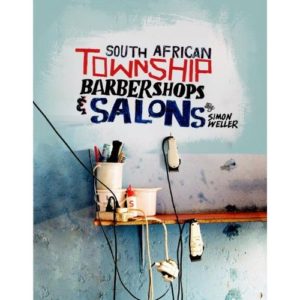South African Township Barbershops and Salons, Simon Weller, Mark Batty Publisher, 128 pages, 2011. ISBN 978-1-935613-04-6. Hard cover $27.95
If African Signs, with its minimal text but rich collection of photographs, provides a window to African vernacular culture, South African Township Barbershops & Salons passes through that window to provide something of an inside tour. Simon Weller, a professional photographer, not only document numerous advertising signs but also spent time with the hair cutters and their customers as well as several sign painters. He aims not just to show the art but also the culture in which the art is embedded. That took him across much of South Africa, both cities and countryside, and into place that few whites, let alone tourists, every visit. In one rural district he asked whether anyone had ever photographed the shops and founds only one case, and that was a government official documenting a structure for possible demolition.
Seeing inside the ramshackle structures, many of them converted steel shipping containers, gives a richer sense of the businesses the signs advertise, including details like their reliance on car batteries for their source of electricity. Weller also sketches the history of strife and the current poverty that are as part of the vernacular as any of the painted images. He observed that the poorer the community, the more the barber shops and salons serve as centers for community interaction.
The artists Weller interviews demonstrate as much variance in their stories as in the styles on view in their work. An artist known as Smoky, active in Soweto, told Weller he had wanted to be an artist since he was five and studied art in college. He paints what he considers fine art but also does commercial signs for income. He works fast, taking from 45 minutes to 2 hours to complete a commercial work.
Chris Masekela, from a rural area outside Pretoria, is self-taught and reports being “inspired by an art gallery that I used to see when I came to town and became interested in white man’s art.”
“I like black man’s art but I like white artists because they show real life and draw towns and people, for instance showing guys playing dice. Black art only shows traditional things like a black woman carrying a calabash on her heard, going to fetch water from the river.”
Masekela’s portraits have a definite edge to them and for whatever reason seem to show less of the American influence (often hiphop in nature) that characterizes much of this work and is widely acknowledged by the artists and their customers.
Weller found another artist who produces versions of his shop signs for sale. Durban painter Espoir Kennedy – actually a refugee from Burundi — said he sells hair signs in a gallery for $95 while charging $40 for actual shop banners.
This review originally appeared in The Outsider, magazine of Intuit: The Center for Intuitive and Outsider Art.

